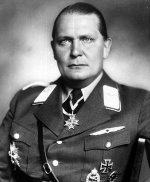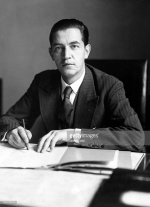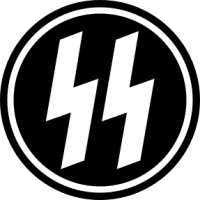Gestapo: Difference between revisions
No edit summary |
|||
| Line 4: | Line 4: | ||
<br> | <br> | ||
== Introduction == | == Introduction == | ||
[[]] | [[File:Hermann Goering 1932.jpg|150px]] | ||
<br> | <br> | ||
<br> | <br> | ||
| Line 10: | Line 10: | ||
== History == | == History == | ||
[[]] | [[File:Rudolf Diels.jpg|150px]] | ||
<br> | <br> | ||
<br> | <br> | ||
Revision as of 11:53, 6 February 2017
Introduction

The force was created by Hermann Göring in 1933 by combining the executive and the judicial branches into one power. Beginning on 20 April 1934, it was under the administration of Schutzstaffel (SS) national leader Heinrich Himmler, who in 1936 was appointed Chief of German Police (Chef der Deutschen Polizei) by Hitler. In 1936, Himmler made it a suboffice of the Sicherheitspolizei (SiPo) ("Security Police"). Then from 27 September 1939 forward, it was administered by the Reichssicherheitshauptamt (RSHA) ("Reich Main Security Office") and was considered a sister organization of the Sicherheitsdienst (SD) ("Security Service").
History

As part of the agreement in which Adolf Hitler became Chancellor of Germany, Hermann Göring—future commander of the Luftwaffe and the number two man in the Nazi Party—was named Interior Minister of Prussia. This gave Göring command of the largest police force in Germany. Soon afterward, Göring detached the political and intelligence sections from the police and filled their ranks with Nazis. On 26 April 1933, Göring merged the two units as the Geheime Staatspolizei, which was abbreviated for a franking stamp and became known as the Gestapo. He originally wanted to name it the Secret Police Office (German: Geheimes Polizeiamt), but discovered the German initials "GPA" looked and sounded too much like those of the Russian GPU.
Its first commander was Rudolf Diels, a protégé of Göring. Diels was appointed with the title of chief of Abteilung Ia (Department 1a) of the Political Police of the Prussian Interior Ministry. Diels was best known as the primary interrogator of Marinus van der Lubbe after the Reichstag fire. In late 1933, the Reich Interior Minister Wilhelm Frick wanted to integrate all the police forces of the German states under his control. Göring outflanked him by removing the Prussian political and intelligence departments from the state interior ministry. Göring himself took over the Gestapo in 1934 and urged Hitler to extend the agency's authority throughout Germany. This represented a radical departure from German tradition, which held that law enforcement was (mostly) a Land (state) and local matter. In this, he ran into conflict with Heinrich Himmler, who was police chief of the second most powerful German state, Bavaria. Frick did not have the muscle to take on Göring by himself so he allied with Himmler. With Frick's support, Himmler (pushed on by his right-hand man, Reinhard Heydrich) took over the political police of state after state. Soon only Prussia was left.
Concerned that Diels was not ruthless enough to effectively counteract the power of the Sturmabteilung (SA), Göring handed over control of the Gestapo to Himmler on 20 April 1934. Also on that date, Hitler appointed Himmler chief of all German police outside Prussia. Heydrich, named chief of the Gestapo by Himmler on 22 April 1934, also continued as head of the SS Security Service (Sicherheitsdienst, SD). Himmler and Heydrich both immediately began installing their own personnel in select positions, several of whom were directly from the Bavarian Political Police like Heinrich Müller, Franz Josef Huber, and Josef Meisinger. Many of the Gestapo employees in the newly established offices were young and highly educated in a wide-variety of academic fields and moreover, represented a new generation of National Socialist adherents, who were hard-working, efficient, and prepared to carry the Nazi state forward through the persecution of their political opponents.
By the spring of 1934 Himmler's SS controlled the SD and the Gestapo, but for him, there was still a problem, as technically the SS (and the Gestapo by proxy) was subordinated to the SA which was under the command of Ernst Roehm. Himmler wanted to free himself entirely from Roehm, who he viewed as an obstacle. Roehm's position was menacing as upwards of over 4.5 million men fell under his command once the militias and veterans organizations were absorbed by the SA, a fact which fueled Roehm's aspirations; his dream of fusing the SA and Reichswehr together was undermining Hitler's relationships with the leadership of Germany's armed forces. Several Nazi chieftains, among them Goering, Joseph Goebbels, Rudolf Hess, and Himmler, began a concerted campaign to convince Hitler to take action against Roehm. Both the SD and Gestapo released information concerning an imminent putsch by the SA. Once persuaded, Hitler acted by setting Himmler's SS into action, who then proceeded to murder over 100 of Hitler's identified antagonists. While members of the Gestapo did not participate in the killing, they supplied the information which implicated the SA and ultimately enabled Himmler and Heydrich to emancipate themselves entirely from the organization. For the Gestapo, the next two years following the Night of the Long Knives, a term describing the putsch against Roehm and the SA, were characterized by "behind-the-scenes political wrangling over policing."
On 17 June 1936, Hitler decreed the unification of all police forces in the Reich and named Himmler as Chief of German Police. This action effectively merged the police into the SS and removed it from Frick's control. Himmler was nominally subordinate to Frick as police chief, but as Reichsführer-SS, he answered only to Hitler. This move also gave Himmler operational control over Germany's entire detective force. The Gestapo became a national state agency. Himmler also gained authority over all of Germany's uniformed law enforcement agencies, which were amalgamated into the new Ordnungspolizei (Orpo: Order Police), which became a national agency under SS general Kurt Daluege. Shortly thereafter, Himmler created the Kriminalpolizei (Kripo: Criminal Police), merging it with the Gestapo into the Sicherheitspolizei (SiPo: Security Police), under Heydrich's command. Heinrich Müller was at that time the Gestapo operations chief. He answered to Heydrich; Heydrich answered only to Himmler and Himmler answered only to Hitler.
The Gestapo had the authority to investigate cases of treason, espionage, sabotage and criminal attacks on the Nazi Party and Germany. The basic Gestapo law passed by the government in 1936 gave the Gestapo carte blanche to operate without judicial review—in effect, putting it above the law. The Gestapo was specifically exempted from responsibility to administrative courts, where citizens normally could sue the state to conform to laws. As early as 1935, a Prussian administrative court had ruled that the Gestapo's actions were not subject to judicial review. The SS officer Werner Best, onetime head of legal affairs in the Gestapo, summed up this policy by saying, "As long as the police carries out the will of the leadership, it is acting legally."
On 27 September 1939, the security and police agencies of Nazi Germany—with the exception of the Orpo—were consolidated into the Reich Main Security Office (RSHA), headed by Heydrich. The Gestapo became Amt IV (Department IV) of RSHA and Müller became the Gestapo Chief, with Heydrich as his immediate superior. After Heydrich's 1942 assassination, Himmler assumed the leadership of the RSHA until January 1943, when Ernst Kaltenbrunner was appointed chief. Müller remained the Gestapo Chief. Adolf Eichmann headed the Gestapo's Office of Resettlement and then its Office of Jewish Affairs (Referat IV B4 or Sub-Department IV, Section B4). He was Müller's direct subordinate.
The power of the Gestapo included the use of what was called, Schutzhaft—"protective custody", a euphemism for the power to imprison people without judicial proceedings. An oddity of the system was that the prisoner had to sign his own Schutzhaftbefehl, an order declaring that the person had requested imprisonment—presumably out of fear of personal harm. In addition, thousands of political prisoners throughout Germany—and from 1941, throughout the occupied territories under the Night and Fog Decree—simply disappeared while in Gestapo custody. During World War II, the Gestapo was expanded to around 46,000 members. After Heydrich's death in June 1942, and as the war progressed, Müller's power and the independence grew substantially. This trickled down the chain of his subordinates. It led to much more independence of action.
